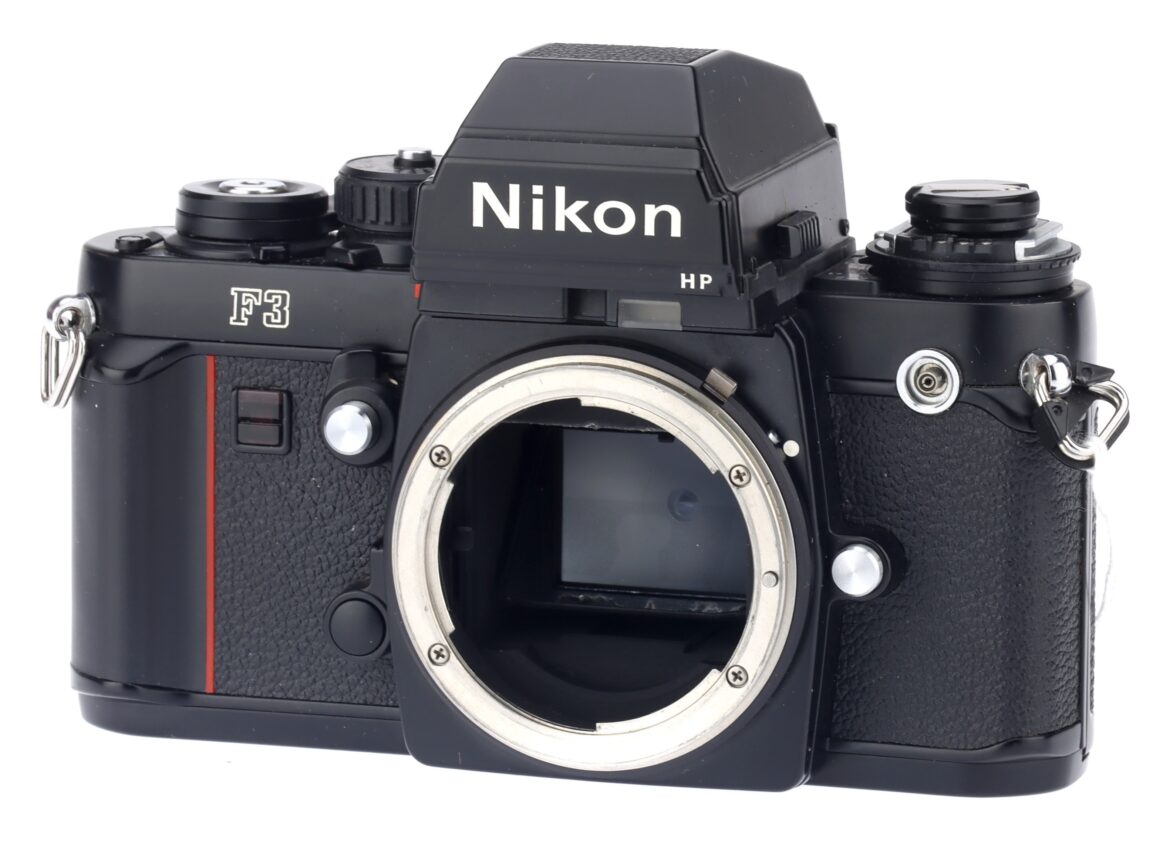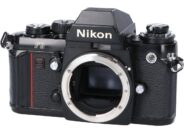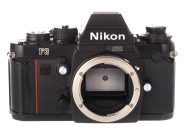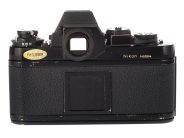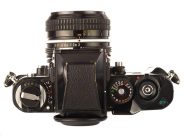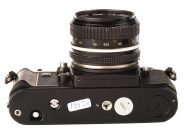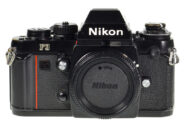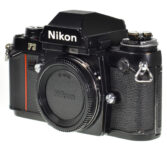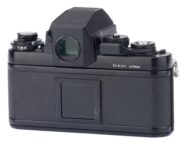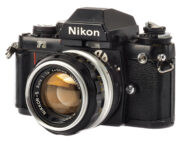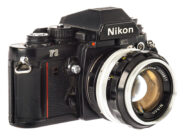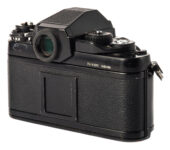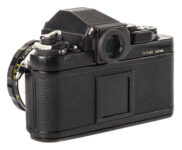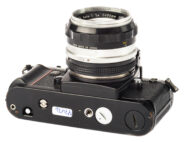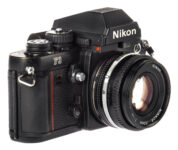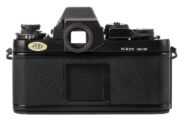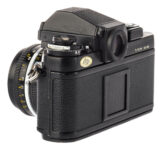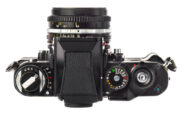Nikon F3
35mm MF film SLR camera • Discontinued
- Announced:
- · 1980
- Production status:
- ● Discontinued
- Country of design:
- · Japan
- System:
- · Nikon F (1959)
Specification
| Format: | |
| 35mm full frame | |
Film type: | 135 cartridge-loaded film |
| Nikon F [46.5mm] | |
| Shutter: | |
Type: | Focal-plane |
Model: | Electronically controlled |
Speeds: | 8 - 1/2000 + B |
| Exposure: | |
Exposure metering: | Through-the-lens (TTL), open-aperture |
Exposure modes: | Aperture-priority Auto |
| Manual | |
| Physical characteristics: | |
Weight: | 700g |
Dimensions: | 148.5x96.5x65.5mm |
Manufacturer description #1
Built on the performance-proven concept and heritage of the original Nikon F and F2, the hand- assembled Nikon F3 is a precision instrument that represents the culmination of over 34 years of camera building experience. The Nikon F3 is the electronic camera of the 1980's; as rugged and durable as it is versatile, for almost any photographic requirement. In the camera, large-scale integrated circuit microprocessors (LSI), which analyze and control camera functions, are protected within the F3's die-cast aluminum alloy chassis, effectively sealed to resist moisture and dust. They provide aperture-priority automatic exposure control and full manual operation with the added accuracy of quartz crystal shutter timing, as well as other sophisticated electronic functions such, as TTL flash metering when combined with the Nikon Speedlight SB-12, or SB-11 and SB-14 when connected via the TTL Cord SC-12. A sensitive silicon photo diode (SPD), located in the mirror box, is heavily center weighted with 80% sensitivity at the center and 20% towards the edges of the frame. The same SPD is used to measure both available light and flash illumination. The F3's light meter remains operational with any accessory finder or focusing screen. The Nikon F3s power consumption is extremely low, thanks, in part, to the revolutionary liquid crystal display (LCD) for exposure readout and other energy-saving features including its automatic meter shut-off circuit. When the F3 is coupled to its motor drive, all power is derived from the MD-4's power supply. Every feature of the professional Nikon F3 has been engineered to the highest quality and maximum efficiency. Its titanium shutter can withstand the rigors of six-frames-per-second motor drive operation, and has been tested to an extraordinary level of 150,000 cycles. In fact, to ensure reliability, the entire Nikon F3 camera is computer tested and retested as each component is assembled. It's this unsurpassed design, construction and quality control that make the Nikon F3 the ultimate SLR.
LCD Viewfinder Display
Full information viewfinder shows either automatic or manual shutter speed with Nikon's aperture-direct-readout (ADR). Power efficient liquid crystal display facilitates comfortable reading even in extremely bright light. Depressing the electromagnetic shutter release halfway activates the F3's meter and LCD readout. The meter circuit remains active for exactly 16 sec. after pressure is released from the shutter button, turning itself off automatically to conserve battery power. On automatic, display shows the nearest standard calibrated shutter speed, with over- or underexposure warnings. On manual, an "M" appears next to the selected shutter speed with "+" and/or "-" indicators for manual metering.
Exposure Compensation
This dial is used to bias the exposure when shooting backlit scenes or dark-toned subjects in deep shade. Settings are in one-third f/stop increments from +2EV to -2EV. (At ASA/ISO 12 and 6400, ±1EV can be set.) This control is also used to bracket or create intentional over- or underexposures with the F3 set on automatic.
Exposure Memory Lock
For proper automatic exposures of subjects in difficult lighting situations, place the subject in the 12mm diameter metering reference area of the focusing screen and press the memory lock to hold the automatic shutter speed setting. Then you may recompose the scene with the subject off-center while maintaining the memorized automatic exposure. The meter reading will then be based on the main subject, not the background.
Depth-of-Field Preview / Mirror Lock-Up Lever
To preview actual depth-of-field or for stopped down metering when using non-meter coupled lenses, press this button. The surrounding lever locks up the mirror for vibration-free operation during critical work such as photomicroscopy.
Electronic Self-Timer
The switch below the shutter speed dial activates the F3's electronic self-timer. Pressing the shutter release button starts the timing cycle. The red LED on the front of the F3 blinks with increasing frequency at the end of the 10 second delay. Turn the switch off to cancel the timing cycle at anytime.
On/Off Switch
The main power switch located around the hub of the fIlm advance lever activates the camera for metering and shooting. Pressing shutter release halfway turns on the LCD viewfinder display. The LCD display will turn itself off automatically in 16 sec. when pressure is removed from the shutter button. When the F3 is switched off, the shutter release button is locked.
Multiple Exposure Lever
This lever disengages film transport mechanism for intentional multiple exposures. The shutter may then be cocked without advancing the ftlm or exposure counter. The multiple exposure lever can also be engaged during motor drive operation. Excellent for special effects.
Mechanical Shutter Release
This lever is used to trip the shutter mechanically at 1/60 sec. when the camera batteries are removed or to conserve battery power when the shutter speed dial is set at "T" for long time exposures.
Viewfinder Illuminator
When the light gets dim, the liquid crystal shutter speed display and aperture-direct-readout in the viewfinder can be illuminated by pushing the red button on the standard DE-2 or DE-3 High-Eyepoint finder. Lights only when meter is on.
Built-In Anatomical Grip
An integral part of the F3 camera body, the contoured handgrip serves as a comfortable handle while shooting. Made of a resilient, slip-resistant synthetic material.
Shutter Speed Dial
Knurled dial locks at "N" and "X" position to prevent accidental movement. In manual operation, all speeds from 1/2000 - 8 sec. and "X" (1/80 sec.) are quartz-timed for accuracy and consistent performance. For time exposures longer than 8 seconds, the F3 can be set at "B", or the mechanically controlled "T" position.
Eyepiece Shutter
During remote camera operation and extreme macrophotography, direct sunlight entering the eyepiece may influence the automatic exposure. Push this lever to close the blind and prevent erroneous exposure readings.
TTL Flash Metering
The Nikon F3's internal silicon photo diode metering cell exhibits instantaneous response to changing light and, therefore, is also used to control flash exposures through-the-lens from light reflected directly off the film plane during the exposure. The TTL system works with Nikon's Speedlight SB-12, or SB-11 and SB-14 when connected to the camera by the optional TTL Sensor Cord SC-12. In addition to providing automatic through-the-Iens flash exposures, each flash unit automatically sets the shutter to its proper synchronization speed of 1/80 sec. when the camera is on automatic or when the shutter speed is manually set to 1/125 sec. or faster. At slower shutter speeds, the F3 will fire at the set speed, permitting fill-flash operation while the TTL function remains operational. When the flash is recycled, a red LED flash ready-light appears in the viewfinder.
When the shutter release button is depressed, the mirror goes up, the shutter opens for 1/80 sec. and the flash begins to fire. The light travels out to the subject and is reflected back through the lens to the film plane. When the silicon photo diode determines that the correct amount of light has reached the film, it electronically tells the flash unit to cut its light output and the shutter then closes.
If the light output was insufficient for a proper automatic exposure, the LED ready-light will blink as a warning. The LED also blink if the camera's ASA/ISO has been set outside the Speedlight's range or if the flash is not properly mounted.
Automatic TTL flash metering with the Nikon F3 provides a number of distinct advantages compared to non-TTL flash photography. Exposure accuracy is more accurate because coverage of the TTL metering cell corresponds to the lens in use rather than the fixed angle for non-TTL units. And, because the exposure is based on the light at the film plane, there's no need to calculate a compensation factor when bouncing the light, using filters or a diffuser on the lens or flash, or even when the lens is extended for close-up photography. Unlike the conventional flash operation which limits the photographer to a few auto-flash aperture settings, TTL flash photography with the Nikon F3 allows free choice of shooting apertures for more complete control over depth-of-field and recycling time. Automatic TTL flash exposures can also be bracketed by engaging the F3's exposure compensation dial.
Manufacturer description #2
TYPE OF CAMERA: 35mm single-lens-reflex
PICTURE FORMAT: 24mm x 36mm (standard 35mm size)
LENS MOUNT: Nikon bayonet mount
SHUTTER: Horizontally traveling quilted titanium focal-plane shutter
SHUTTER RELEASE BUTTON: Electromagnetically controlled: switches meter on when depressed halfway (after power switch is turned on), meter then remains on for 16 sec. after finger is taken off button and turns off automatically; threaded to accept standard cable release
BACKUP MECHANICAL RELEASE LEVER: Trips shutter at 1/60 sec. regardless of shutter speed dial setting (except "T"); used when batteries become weak or exhausted, or none are installed in the camera
AUTOMATIC EXPOSURE CONTROL: Aperture-priority automatic exposure control; stepless shutter speeds from 8 sec. to 1/2000 sec.
MANUAL EXPOSURE CONTROL: Quartz digital control for 16 shutter speeds from 8 sec. to 1/2000 sec., including "X" (1/80 sec.); "B" and "T" also provided, as well as 1/60 sec. mechanically controlled speed
MECHANICAL SHUTTER CONTROL: Possible at "T" setting on shutter speed dial or at 1/60 sec. when using backup mechanical release lever
VIEWFINDER: Interchangeable eyelevel pentaprism type DE-2 as standard; 0.8X magnification with 50mm lens set at infinity; virtually 100% frame coverage
EYEPIECE SHUTTER: Provided; prevents stray light from entering viewfinder through the eyepiece
FOCUSING SCREEN: Type K as standard; interchangeable with 19 other types
EXPOSURE METERING: Through-the-lens center-weighted metering with an 80/20 balance; silicon photo diode (SPD) and metering circuits incorporated into camera body; meter works with all interchangeable viewfinders and focusing screens
METERING RANGE: EV 1 to EV 18 (i.e., f/1.4 at 1 sec. to f11 at 1/2000 sec. with 50rnm f1.4 lens and ASA/ISO 100 film)
FILM SPEED SETTING: ASA/ISO 12 to ASA/ISO 6400
ACCESSORY SHOE: Provided; special Nikon type located at base of rewind knob; accepts SB-12 Speedlight Unit or SC-12 TTL Sensor Cord from SB-11/SB-14 for TTL direct flash output control; flash couplers are available for mounting ISO-type or F2-type direct mounting flash units
FLASH SYNCHRONIZATION: Speeds up to 1/80 sec. with electronic flash; with SB-12 (or SB-11 and SB-14 when connected via the SC-12 TTL cord), flash sync is automatically set to 1/80 sec. when shutter speed dial is set to "A", or 1/125 sec. or above; at manual shutter speeds of 1/60 sec. or slower, flash sync speed corresponds to that setting; threaded sync terminal provided for off-camera or multiple flash photography
VIEWFINDER DISPLAY: Liquid crystal display (LCD) shows shutter speed; on Auto, +2000 indicates overexposure, -8- underexposure; on Manual, "M" appears with "+" indicating overexposure, "-" underexposure, and "-+" correct exposure; LED ready-light glows when SB-11, SB-14 or SB-12 Speedlight unit is completely recycled; aperture in use also shown through aperture-direct-readout (ADR) window
VIEWFINDER ILLUMINATOR: Provided; illuminates both LCD and ADR f/number
EXPOSURE COMPENSATION DIAL: Provided; +2 to -2 EV in one-third increments
EXPOSURE MEMORY LOCK: Provided
MULTIPLE EXPOSURE LEVER: Provided
SELF-TIMER: Quartz-controlled 10-sec. delayed exposure; LED blinks at 2 Hz for first 8 sec., then at 8 Hz for last two sec.
REFLEX MIRROR: Automatic instant-return type with lockup facility; incorporates air-damper and brake mechanism for reduced vibration and noise; special non-silvered spots provide TTL meter operation
DEPTH-OF-FIELD PREVIEW: Provided; coaxial with the mirror lockup lever
FILM ADVANCE LEVER: Wound in single stroke or series of strokes; 30 stand-off angle and 140 winding angle
FRAME COUNTER: Additive type; automatically reset when camera back is opened
FILM REWIND: By crank after film rewind button is depressed; automatic film rewind possible when MD-4 Motor Drive is used
CAMERA BACK: Hinged, interchangeable type; opened by pushing safety lock while pulling up rewind knob; memo holder provided
BATTERIES: Two 1.5V silver-oxide button type cells installed in clip fitting into camera's baseplate; when MD-4 Motor Drive is attached, camera gets battery power entirely from batteries in motor drive
Manufacturer description #3
F3
- Top-of-the-line professional quality camera.
- Responsive, accurate aperture-priority automatic exposure control; quartz oscillator assures precise manual shutter speed timing from 8 to 1/2000sec.
- Viewfinder with virtually 100% picture coverage shows you the exposure information you need at a glance.
- Complete interchangeability of six finders, 22 focusing screens and camera backs including the MF-4 250-exposure Film Back, the MF-14 Data Back, the MF-6B and the MF-17 250-exposure Data Back.
- Dedicated, direct, through-the-lens (TTL) automatic flash metering capability with SB-11, SB-14, SB-17 and SB-16A.
- Accepts the MD-4 Motor Drive which fires at up to six frames per second.
- Viewfinder exposure readout consists of easy-to-see Liquid Crystal Display (LCD) of shutter speed, ADR (Aperture Direct Readout) aperture number in use and flash ready-light.
F3HP
- Offers all the F3 advantages, and uses DE-3 High-Eyepoint view-finder which provides comfortable viewing whether you wear eye-glasses or not, or even with your eye up to 25mm away from the eyepiece.
F3/T
- Offers all the features of the F3HP in a tough body with a titanium finish; one of the world's strongest metals, titanium gives added protection to the camera's high-eyepoint viewfinder, camera top and bottom, and the entire camera back.
F3AF
- Auto focus operation with dedicated AF Nikkor lenses having built-in motor.
- Auto focus Teleconverter TC-16 enables auto focus operation with Nikkor lenses having f/2 or faster.
- Motorized autofocus shooting with the MD-4 Motor Drive and MK-1 Firing Rate Converter at a pre-selected firing rate of 3.2 and 1 fps.
From the Nikon Journal (Vol. 23 No. 4, September 30, 2006)
About 6 months after the introduction of the F3, the design team was sent on a world tour to gain as much feedback from professionals and repairmen as possible. They listened with open ears to alI suggestions made to them. In 1981 a series of small modifications to fine-tune the F3 begun.
1981 improved model:
- Main circuit board received better protection from water
- Front & back covers were improved with more foam strips
- lmproved design of the flash shoe
- Improved motor drive coupling
- Improved on/off power switch on the shutter speed selector
- Improved rubber rings on the mirror lock-up button
- Bottom cover protected intemally with oil barrier coating
- Strengthened camera back lock lever
- Multiple exposure lever reduced in size
- Rewind button slightly enlarged
1982 improved model:
- 'O' ring added to shutter speed selector to block moisture
- New battery holder for one 3V instead of two 1.5V cells
1983 improved model:
- Memory lock button improved & held in pIace with a small clip inside the mirror box (button now metal & not plastic)
MD4 Motor Drive improvements (started at #100021):
- Sept. 1980: Early models recalled for battery clip button renewal
- Dec. 1980: Noise reduction improvement
- May 1983: Improved water resistance and protection
- July 1984: Improvements to the integrated circuit
As far as we can ascertain, no more modifications or improvements were made or needed. The F3 had reached pure perfection. Well, almost. Four points that should have been redesigned are:
- That little red display illuminator button that rarely works
- The LCD display could have been better
- The motor connection that allowed light to fog the film if the motor was removed with film loaded
- The tripod mount on the motor was way off to one side
One point to address is the flash sync. Why did the Nikon F3 only ever have a sync speed of 1/80th sec? The FM2 had a sync speed of 1/250th so why did Nikon not upgrade the F3? It must have lost them sales to arch rival Canon.
To insure the durability of the F3 under actual working conditions, a random selection of cameras was taken from the production line and tested to almost destruction with 150,000 shutter firings! Bodies were placed on a vibration shaker plate with no protective packaging and vibrated for 1 hour at various frequencies to see of screws would vibrate loose, or if it would explode. This was helI and back for the Nikon F3, and it lived to work another day. Over 26 years later stories of 1,000,000 exposures on F3s have become quite common. That's 28,000 rolIs of film, or 182 kilometers!
Nikon F3 special editions (4)
- Nikon F3 Limited (2500 units) - October 1993
- Nikon F3/T (300 units) - December 1982
- Nikon F3H - June 1996
- Nikon F3P - 1984
Similar cameras (6)
| Model | Shutter | Metering | Modes | Year |
|---|---|---|---|---|
| Kiev-17 akaКиев-17 |
M, 1/1000 | -- | M | 1978 ● |
| Kiev-19 akaКиев-19 |
M, 1/500 | TTL · WA | M | 1985 ● |
| Kiev-19M akaКиев-19М |
M, 1/500 | TTL · OA | M | 1988 ● |
| Kiev-20 akaКиев-20 |
M, 1/1000 | TTL · OA | M | 1983 ● |
| Nikkorex F akaNikkor J |
M, 1/1000 | -- | M | 1962 ● |
| Ricoh Singlex | M, 1/1000 | -- | M | 1962 ● |
